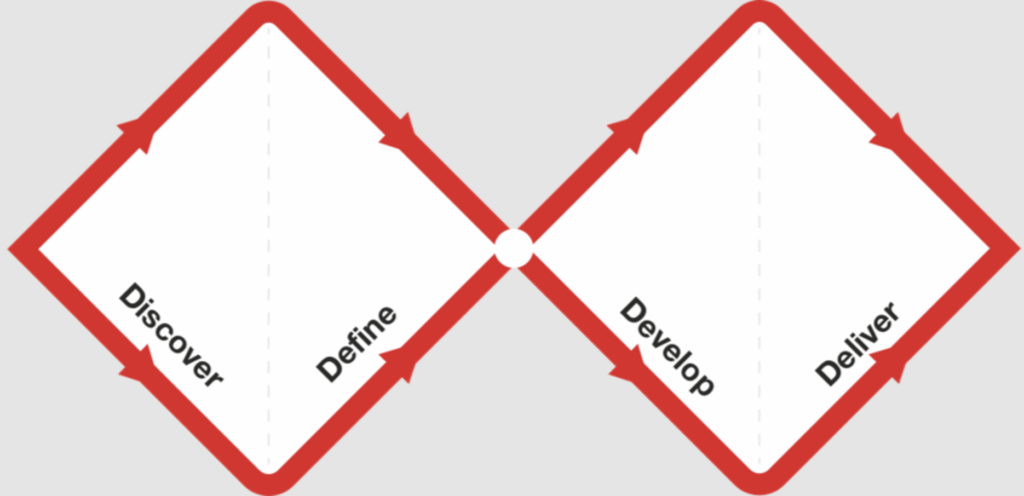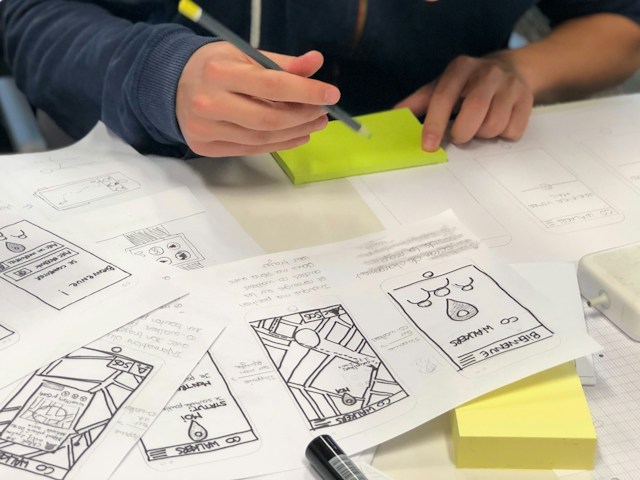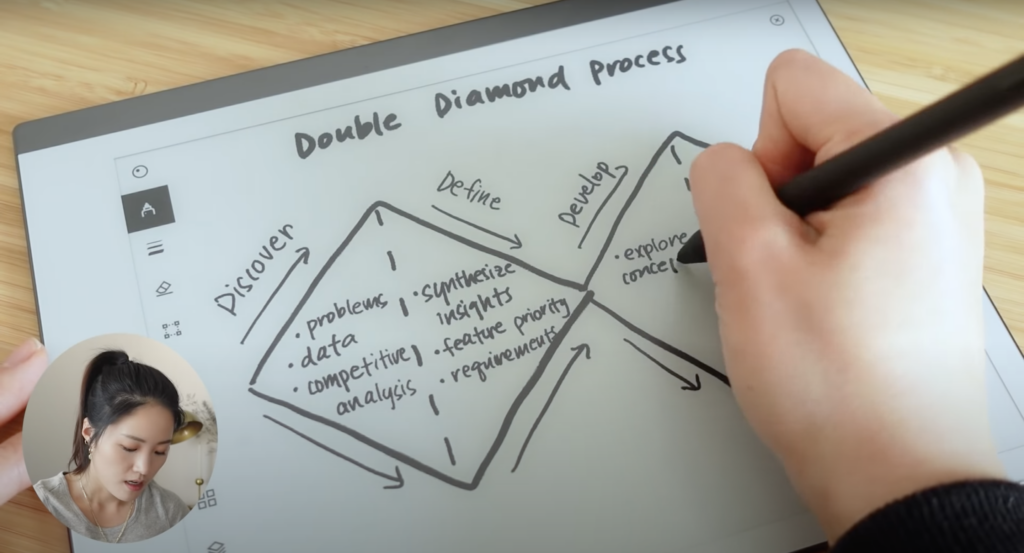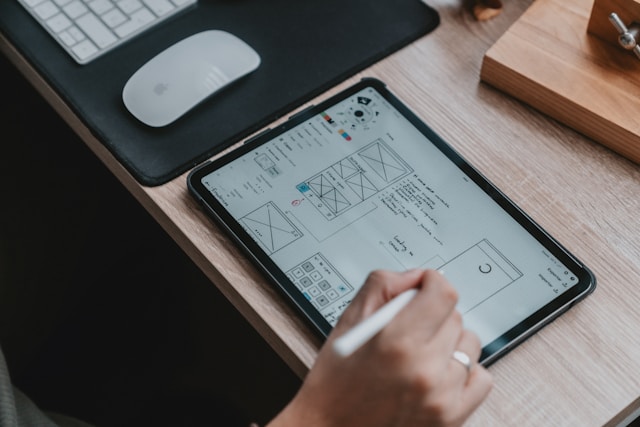Imagine a client has asked you to enhance the user experience (UX) of an app. You’re not sure how users navigate to the explore page, and you believe adding a new feature would make a great impact. It seems like there is a lot to improve, but you lack the time and resources to cover everything. As the only designer on the team, it’s important to build a strong relationship with your client and stakeholders. Presenting the Double Diamond design process can make it easy for non-designers to understand the design process. Using the Double Diamond process also makes sure you create user-centered solutions rather than following your own intuition.
So, what is the Double Diamond design process? In this article, we’ll cover what it is and how to use it to back up your design decisions.

What Is the Double Diamond Design Process?
The Double Diamond process sets you up to solve problems effectively. Often used in the design field, this framework helps teams explore issues deeply and then take focused action. Launched in 2004, the Design Council presented this framework as a clear and visual description of the design process.
Visualized as two diamonds, it starts with divergent thinking. Instead of assuming a problem or solution, you take the time to think of the issue more deeply and explore it widely. Then, it shifts to convergent thinking, where you actively take action based on what you have discovered or developed. This framework takes you from exploring many ideas to coming up with a solution you’re confident with.
Although the arrows on the diamond make the process look linear, design teams do not have to be rigid. You might go back and forth between the phases. The fluidity and explorative nature of the framework allow you to dig deep and explore infinite possibilities. Ultimately, you go through all the possibilities to reach a solution backed up by research.
To break down the Double Diamond design process further, let’s take a look at the four stages.
Discover
The beginning of the diamond starts with discovery. Many times, we assume what the problems are, but this phase asks you to understand people. You can do this by conducting interviews with the target audience and making observations. Similar to Design Thinking, it’s a time to be empathetic. In this phase, you uncover challenges and opportunities. When talking with users, focus on their behavior, thoughts, and feelings.
During this discovery phase, designers should be cautious about fixating on a certain problem or idea. Remember, you are discovering here, not validating your assumptions. Also, it’s important to disregard feasibility to be able to come up with as many ideas as possible. You can rule out unfeasible ideas later.
It takes time to discover problems, so explore the problem from every angle. Use research and user testing to understand the problem space.

Define
After exploring many ideas and problems, it’s time to sift through all the information. Define the problem or challenge based on the insights gained in the discovery phase.
In this phase, you’ll end with a definitive problem statement or problem definition. It helps establish a clear direction for the design process.
Some key aspects of the “Define” phase:
- Synthesize Insights: Designers go over all the data collected in the “Discover” phase. You’re looking through user interviews, observations, surveys, and other research methods. Identify patterns and themes to refine the most relevant and meaningful insights.
- Persona and Empathy Mapping: Developing personas humanizes the design process. You can refer to the personas throughout the project to remember the needs and behaviors of the target users. Empathy mapping is another way to understand users’ emotions, behaviors, and pain points.
- Problem Definition: As mentioned before, designers articulate a clear and focused problem statement in this stage. Defining the problem helps avoid solving symptoms instead of the root cause. You’re addressing actual user needs. The problem statement you end up with may not be what you started with. Use the data to refine and iterate on the problem statement.
- Stakeholder Alignment: Everyone on the team, including stakeholders, needs to align on the defined problem and goals of the design project. This allows for easier collaboration and shared understanding.
All the ideas generated previously become a clearly defined problem by the end of this phase.

Develop
In this phase, we go back to divergent thinking. Using our defined problem statement, it’s time to brainstorm and think about all the potential solutions. We’re not fixating on one solution here. Take the time to think of all the ways to solve the problem that resonate with the users. Let the creativity and innovation flow through brainstorming and other ideation techniques.
When brainstorming, generate ideas without immediately evaluating or critiquing them. This approach ensures that you explore all possible ideas. Several techniques, such as brainstorming and mind mapping, help in stimulating creativity and exploring diverse perspectives.
A lot more happens after brainstorming. Prototyping helps to test design ideas. Low-fidelity sketches or high-fidelity prototypes turn ideas into interactive models. Rapid prototyping allows for quick iterations, test sketches, and prototypes to get user feedback. This helps improve designs.
Collaboration is also crucial during this phase. Working with others helps to bring more perspectives to the table. Also, asking for feedback helps refine concepts. Collaborating helps with making sure the design direction remains aligned with user needs and project goals.
The Develop phase involves ideation, prototyping, testing, and iteration. It starts off with exploring all the possibilities to narrowing down to a few concepts. Remember to always refer back to the defined problem when making decisions. Does this idea or solution effectively address the defined problem?
Deliver
The final stage of the Double Diamond design process focuses on bringing the selected solution to fruition. Designers work on finalizing and implementing the design.
In the Deliver phase, continue refining and finalizing prototypes as the design approaches its final version for implementation. Use usability testing results to bring your design to a more user-centered solution.
Once stakeholders and other collaborators approve the final design, developers bring it to life. Designers then monitor the launch to gather feedback for future improvements.
Ultimately, this last phase transitions from exploring solutions to concrete implementation of the final design.

Mobile App Example: Using Double Diamond To Guide Your Design
Now that we know the Double Diamond process better let’s go through it using an example problem. We’ll follow the example Christine Chun, a product designer, gives us in her YouTube video.
- Example Design Prompt: Redesign the item detail page for an e-commerce mobile app. A vague or ambiguous design problem may be overwhelming to tackle. However, using the Double Diamond provides clarity on how to break down the big design problem on smaller problems.
- Discover: Explore the problem space more. Ask questions, and think about what works well or what does not work well. Use data and competitive analysis to understand the problem space further. A key measurement Christine uses for this example is “What percentage of users add suggested items to the cart from the item detail page?” Item detail pages contain many different components, so explore all the problems that may be occurring.
- Define: This is the moment to synthesize your data and prioritize what your team will work on. Christine wrote a list of features to add and prioritized the improvements by highest impact with her team. One feature she identified as needing improvement is to “show customers other item recommendations if the current item doesn’t fulfill their shopping needs.” She further broke this down into three smaller tasks.
- Develop: You know what you will be working on, so now it’s time to explore solutions. For this particular example, it looks like sketching screens and exploring different layouts to show recommended items. Christine sketched layouts showing a grid view of items and even a tab view of recommended items.
- Deliver: This is the phase where you refine your solutions. Conduct lots of user testing to make sure the solution has the impact they are looking for. After several iterations, you and your team will end up with a design or two to launch.
Double Diamond vs. Design Thinking
Design Thinking, another common design process, shares similarities with the Double Diamond design process. Let’s go over the similarities and differences between the two approaches:
Similarities
- Iterative Process: Both frameworks embrace an iterative process. They go through repetitive cycles of ideation, prototyping, testing, and iterating to improve solutions.
- Problem Framing: Both frameworks emphasize the importance of clearly defining and framing the problem before moving on to finding a solution. Without a clear problem statement, how can you come up with an effective solution?
- Creativity and Ideation: Both frameworks also encourage creativity. They both include dedicated phases for generating a wide range of ideas.
Differences
- Structural Framework: The Double Diamond process includes four distinct stages (Discover, Define, Develop, and Deliver). Design Thinking has five stages (Empathize, Define, Ideate, Prototype, and Test).
- Degree of Detail: The Double Diamond provides a detailed roadmap for designers by suggesting certain activities at specific stages. For example, empathy mapping and persona development aid in defining the problem. Design Thinking allows for flexibility in how teams approach each stage. The broader framework allows designers to choose the methods to use at each stage rather than being as specific as the Double Diamond.
Both Double Diamond and Design Thinking processes act as a guide to problem-solving. Some designers may consider the Double Diamond more specific and structured compared to Design Thinking. However, a lot of the process overlaps, so use what works best for you and your team. Just make sure you keep the users in mind throughout the design process. Use the data collected to guide you to a user-centered solution.
Driving Success With the Double Diamond Process
The Double Diamond design framework guides designers and non-designers through a journey of problem exploration to solution implementation. Although structured as two diamonds with arrows, designers may backtrack if they discover something new during the process. For example, you and your team focused on a solution to realize that it did not meet user needs. Now you know that idea does not work, and you go back to exploring more ideas. This framework simplifies design understanding. Design teams employ various methods for exploring and refining ideas, enhancing the creative process. As design evolves, the Double Diamond still remains as an inspiring problem-solving process to deliver meaningful experiences that resonate with users.
If you’re seeking design inspiration, consider drawing insights from proven products that may have used the Double Diamond design process. Page Flows offers a valuable resource for discovering interaction design ideas. Dive in today and explore our expanding library of user flow recordings and stay current with evolving design trends.




